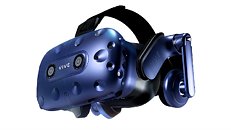Wednesday, November 28th 2018

SteamVR's Motion Smoothing Exits Beta, Enabled Now By Default on Windows 10 PCs With NVIDIA GPUs
A few weeks ago Valve developers announced a new technology called Motion Smoothing that would enable low-end GPUs to support VR games without problems. The system "looks at the last two delivered frames, estimates motion and animation, and extrapolates a new frame. Synthesizing new frames keeps the current application at full framerate, advances motion forward, and avoids judder".
Motion Smoothing has been available in Beta for some time, but the test phase has come to an end and it seems the technology is ready to enter the final, stable stage. You'll still need an HTC VIVE or HTC VIVE Pro headset -Oculus Rift and Windows Mixed Reality headset have their own display drivers with other tricks to sustain frame rates-, and the lack of AMD GPU support is somewhat disappointing, but hopefully Valve will fix this in future iterations of this technology.
Source:
KitGuru
Motion Smoothing has been available in Beta for some time, but the test phase has come to an end and it seems the technology is ready to enter the final, stable stage. You'll still need an HTC VIVE or HTC VIVE Pro headset -Oculus Rift and Windows Mixed Reality headset have their own display drivers with other tricks to sustain frame rates-, and the lack of AMD GPU support is somewhat disappointing, but hopefully Valve will fix this in future iterations of this technology.


9 Comments on SteamVR's Motion Smoothing Exits Beta, Enabled Now By Default on Windows 10 PCs With NVIDIA GPUs
Somehow this keeps my hopes up for a HL3 at some point. They're just taking a really long time, when nobody wants it anymore, they'll release it.
And yeah, keep on dreaming VR is dead
It needs more time. The giant bulky head set, the wires, space limitations. there's enough immersion breaking hurdles ,that make it less immersive than traditional PC gameplay imo. It just needs "more". Its impressive, & cool, but a great way to determine the feasibility of a given product is to apply the "razor and blade" model to it hypothetically & honesty think if it would survive.
If you're unfamiliar, the "razor and blades" model is when you provide the main item at a minimal to no-cost, and have refillable items which is where you actually make your money that are required for the main item to function . Very similar to printers and printer ink. You can often get a decent printer for $50 or less, and they're often sold at a loss or low profit, because manufacturers know they can sell ink at a ridiculously high mark up (which is why there are now chips in ink cartridges to determine if they are "genuine ink" since if you buy your ink from another seller the company that footed the bill on the printer wont make its money),because what good is a printer without ink ? Just like shaving razors, so hence the name
so ,if you were to apply that method to VR right now ,do you really think it would do well? Let's just say that all the equipment required to get a capable gaming PC up and running in VR costed $50 , but the games would cost $150, or $100 ,how many games do you think VRbuyers would purchase ,before they said "nah this isnt worth it"? I would be genuinely surprised if consumers bought a second title beyond the first
But that's just my opinion
Valve is simply using NVidia's recent frame interpolation algo for generating slo-mo or high-FPS videos from low-FPS source.
Basically, minimal work, minimal R&D, and ready-to-use inference algorithm (just a slightly different application).
I mean this, but in real-time:
If one could have a free or low cost GTX 1080 Ti, Titan or RTX 2080 Ti video card but couldn't use it to run any existing games; rather one could only use these new cards with new ~$150 title games,....how many would go for that gleefully,.....!?! Not many I would wager.
You see, apply this model to just about anything and you'll get consumer resentment. People have a tendency to pick up on when they are being subjected to predatory business practices (if not immediately then eventually).
FWIW, with printers I would buy ~$30 to ~$40 inkjet printers and give them away when the ink ran out. Then start the cycle over again. Until I found a printer I really liked that is.
Also, for what its worth, it is rumored that Valve will be releasing a new HMD at cost. Whatever, that cost miay be.
But it won't be working for VR. They'll never give away HMDs so this razor and blade model... Im not seeing it. All I see is overpriced razors... and the blades go dull after one or two runs.
INput lag Garbage!
Why don't they use Variable refresh rates? Like Freesync or Gsync?